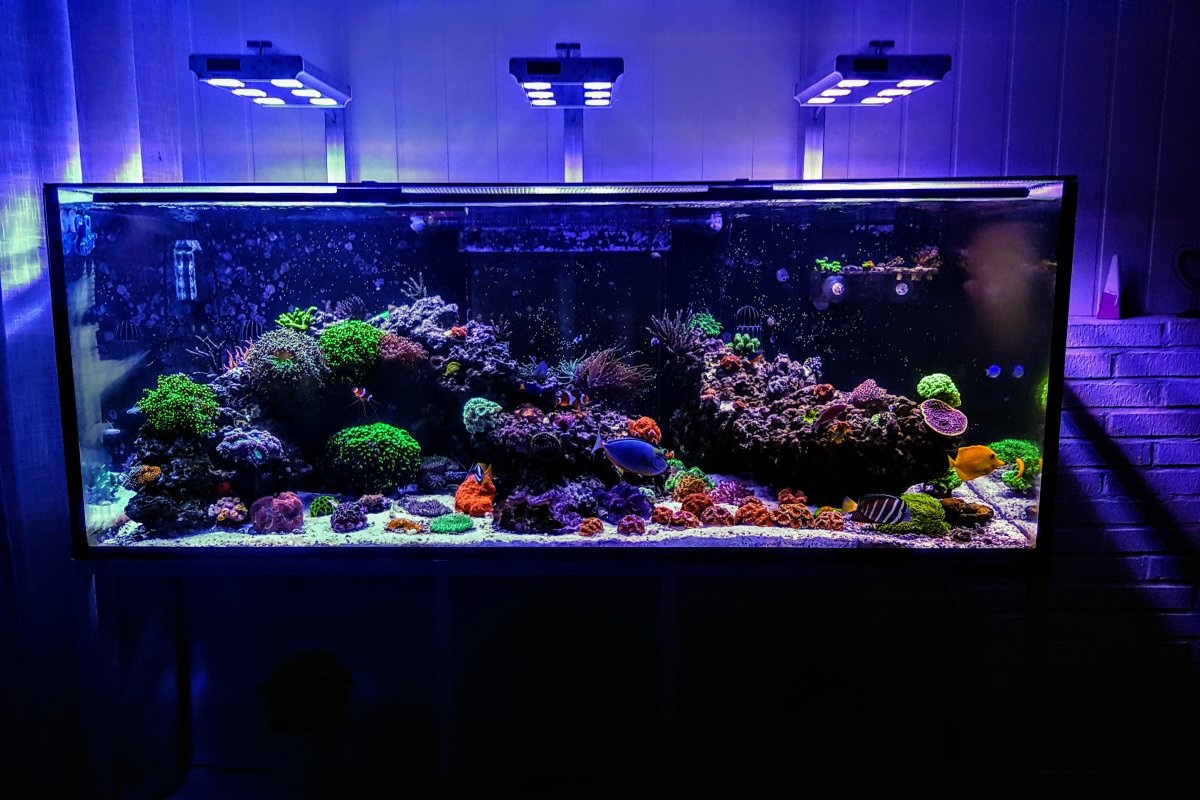Saltwater tanks, called “reef tanks” in the hobby, are some of the most rewarding fish tanks you can set up.
They are a little more complex than standard freshwater tanks, but there is something very rich and rewarding in carefully cultivating and tending to this utterly unique ecosystem, and if you love fish, this could be a great step for you.
In this article, we’re going to break down some of the easiest saltwater fish for beginners, as well as some tank basics. This info will have you feeling far more confident in your new hobby, so, let’s get started.
Contents
Clownfish
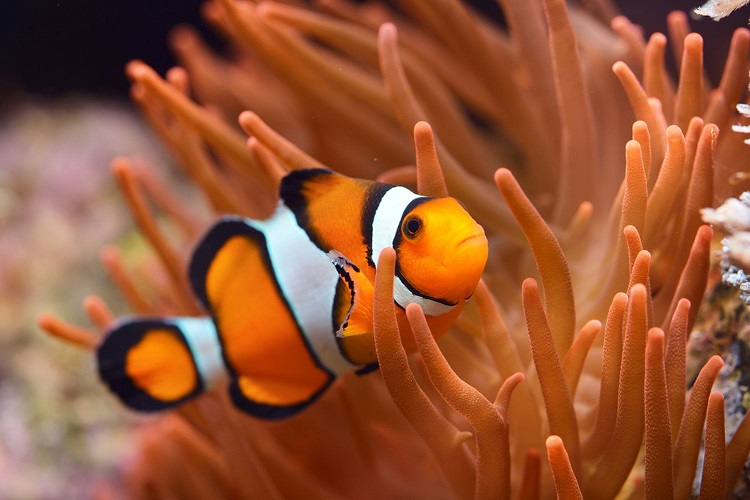
Not only is the Clownfish one of the most recognizable saltwater aquarium fish, but it’s also a fantastic choice for beginners who want a tolerant and hardy fish that will let them learn. There is an amazing variety of these beautiful fish, with about 30 species to enjoy, and there are some captive-bred variants too.
The Ocellaris Clownfish (Amphiprion ocellaris) is one of the most common types of Clownfish, and it’s a great addition to smaller community tanks. Some of the larger Clownfish can be more aggressive but will work well in involved ecosystems and big reefs.
At a Glance:
- Scientific Name: Amphiprion and Premnas genus, many species
- Adult Size: 3–6 inches
- Recommended Tank Size: 20 gallons
- Temperature: 75–80 °F
Yellow Watchman Goby
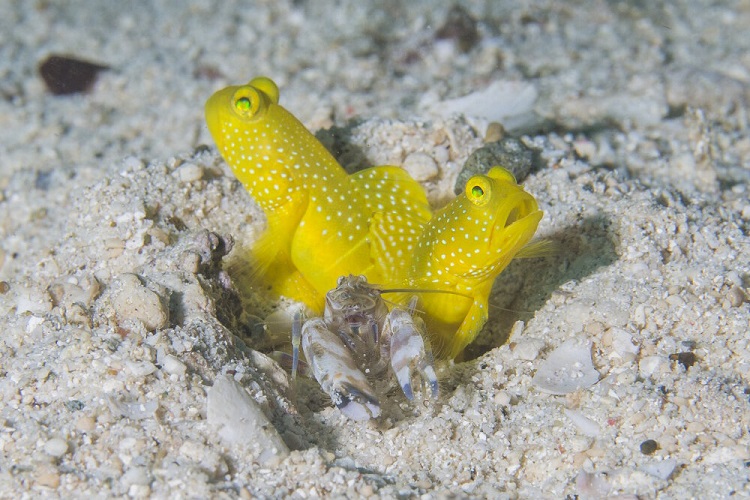
This is a fun addition to a beginner saltwater fish tank. It also works fantastically when paired with one of its symbiotic pistol shrimps—typically the Tiger Pistol Shrimp (Alpheus bellulus). This pair make for a great nano reef tank setup. With their flamboyant bright yellow coloration, they make for beautiful activity at the bottom of your tank.
They can be a little shy and will burrow tunnels in your substrate, something the pistol shrimp will help them maintain. But you’ll soon see them out-and-about, foraging and conducting “home improvements.”
At a Glance:
- Scientific Name: Cryptocentrus cinctus
- Adult Size: 4 inches
- Recommended Tank Size: 20 gallons
- Temperature: 72–82 °F
Banggai Cardinalfish
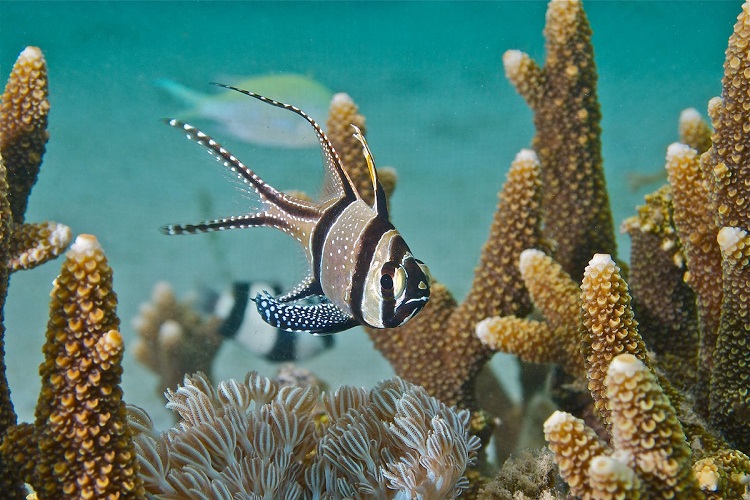
Also called Kaudern’s Cardinalfish, this is a desirable cardinalfish that is beginner-friendly. They’re mouthbrooding fish, so they can breed successfully in aquariums if you’re looking for an added challenge as you get more experienced. But despite their small size, their gorgeous white and black coloration is spectacular.
Most commercially available Bangaii cardinalfish are aquacultured because they’re rare in the wild.
At a Glance:
- Scientific Name: Pterapogon kauderni
- Adult Size: 3 inches
- Recommended Tank Size: 30 gallons
- Temperature: 72–82 °F
Green Chromis

This is one of the most imported saltwater fish in the world, and it’s easy to see why. They have fantastic colors, are a vivacious and energetic tank addition, and shoal beautifully. They are also surprisingly cheap!
In captivity, they can live for around a decade. However, in a shoal, they tend to be shorter-lived. They are a simple and beautiful addition to any novice reef tank.
At a Glance:
- Scientific Name: Chromis viridis
- Adult Size: 3 ½ inches
- Recommended Tank Size: 30–40 gallons
- Temperature: 79–82 °F
Coral Beauty Angelfish (Tank-raised)
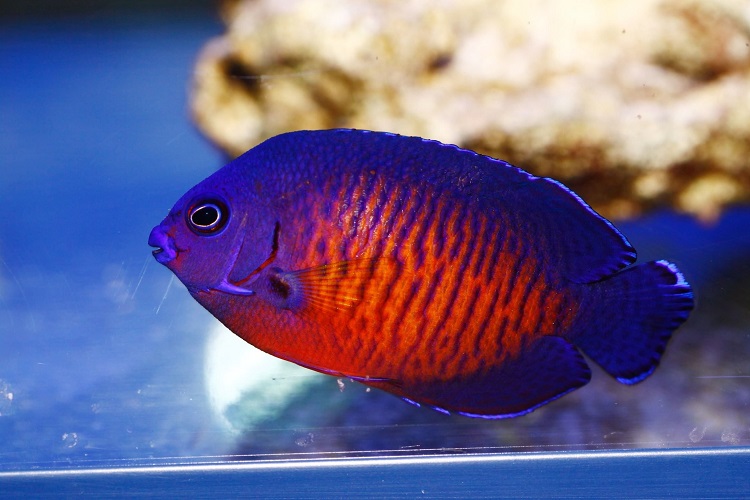
While you’ll often see this fish recommended for nano tank setups, it deserves a lot more. They’re small, but they like to roam, and they need a decent amount of algae (or supplementation) to snack on. For saltwater fish, they’re pretty peaceable but can be a little nippy with corals.
They’re very similar to the Flame Angelfish (Centropyge loricula), but a little easier to keep. Do be aware that they don’t “play well” with very similar species, like the Flame Angelfish, a problem you’ll encounter a lot with saltwater fish and should always consider when stocking your tank. Tank-raised are better for beginners, as they are hardier fish and adapt better.
At a Glance:
- Scientific Name: Centropyge bispinosa
- Adult Size: 4 inches
- Recommended Tank Size: 70 gallons
- Temperature: 74–82 °F
Royal Gramma

The Royal Gramma had a guest appearance in the Finding Nemo films, and they make a beautiful addition to beginner saltwater fish setups too. With bold yellow and royal purple coloration, they’re immensely appealing, and they stay small.
They’re inexpensive and very hardy. They can be surprisingly aggressive, however, especially to similar-looking species with less time in the tank than them. Add them to your setup last, or monitor them carefully for aggression.
At a Glance:
- Scientific Name: Gramma loreto
- Adult Size: 3 inches
- Recommended Tank Size: 30 gallons
- Temperature: 72–78 °F
Pajama Cardinalfish (Tank-raised/Aquacultured)
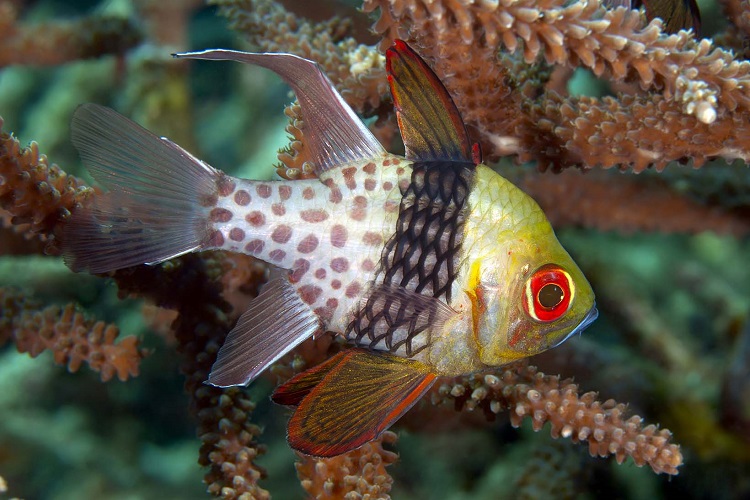
While often seen as the less desirable version of the Banggai Cardinalfish, these lovely saltwater fish need some attention of their own. They group nicely and have a beautiful coloration that is so vibrant it can seem artificial. With appealing large eyes, they’re also a rather peaceful member of the saltwater family.
While you’ll most often find wild-caught fish, it can be worth looking for an aquacultured variety, as they’re a bit hardier and will adapt better to your tank.
At a Glance:
- Scientific Name: Sphaeramia nematoptera
- Adult Size: 3 inches
- Recommended Tank Size: 30 Gallons
- Temperature: 72–78 ºF
Helfrichi Firefish
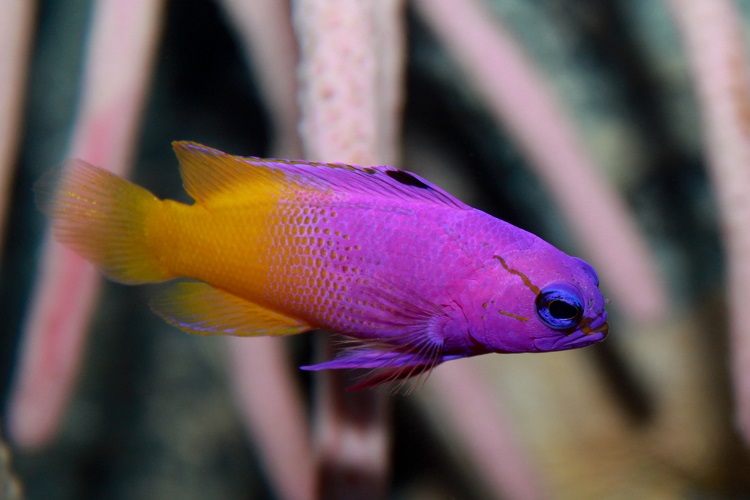
Firefish, in general, make great additions to a beginner reef tank. They’re one of the most colorful saltwater fish around, and the Helfrichi Firefish is the smallest of the species. They do no harm to invertebrates or coral but need to be paired with gentle-natured fish like them to thrive.
Do note that Firefish are notorious jumpers, and can sometimes escape even lidded tanks, so plan accordingly and make sure the lid is tight.
At a Glance:
- Scientific Name: Nemateleotris helfrichi
- Adult Size: 1.5 inches
- Recommended Tank Size: 20 Gallons
- Temperature: 72–78 ºF
Mandarin Dragonet

While we caution against Mandarins in general for beginners, this is the one exception that might work in a beginner saltwater fish setup. However, do take a glance at our notes about feeding them below, as they can be very difficult eaters and need special care if you choose to include them.
This is one amazingly gorgeous fish. Because they’re slow-swimming and small, they’re easier than many other Mandarins to keep, and people are drawn to them. They live as long as Clownfish in the right environment and with the right food. They don’t do well in mixed reefs, being shy and retiring by nature, but suit almost any tank size.
At a Glance:
- Scientific Name: Synchiropus splendidus
- Adult Size: 3 inches
- Recommended Tank Size: 30–40 Gallons
- Temperature: 72–82 ºF
Chalk Bass
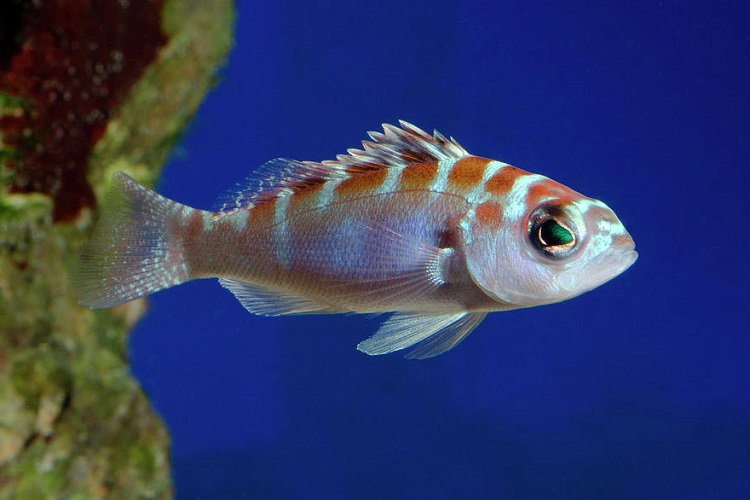
If you’d like a more uncommon saltwater fish that is still easy to care for, this could be the perfect fish for you. While they’re slightly plain next to other saltwater fish, they still have an appalling blue-white base color overlaid with red stripes on their dorsal.
They’re very hardy, and make great additions to a community reef tank. They don’t school but do like grouping. While they may be a little shy on introduction, you’ll soon see them out in the open if you create the right setup to nurture them.
At a Glance:
- Scientific Name: Serranus tortugarum
- Adult Size: 3 inches
- Recommended Tank Size: 30 gallons
- Temperature: 72–76 ºF
Candy Pipefish
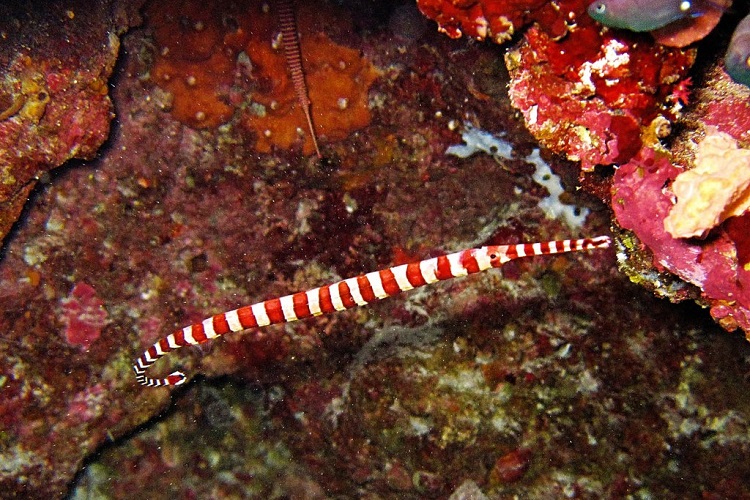
This is probably the hardiest pipefish and can be good for advanced beginners, although they’re a lot more difficult to keep than the others on our list. Strictly speaking, it’s more closely related to the seahorse than fish, but it makes for an interesting addition to your reef tank. You’ll find them close to the bottom, but rarely at the substrate level.
The Candy Pipefish has an attractive and bold cream and red coloration with dark rings. They need to be kept in mated pairs or small groups and only do well with shy and small fish, like dragonets, seahorses, and firefish.
They don’t like fast-moving or aggressive fish and don’t do well with corals that sting, corals that consume small fish (brain coral), or anemones. Some invertebrates are also hostile to them. However, they’re a nice challenge in the right tank.
At a Glance:
- Scientific Name: Dunckerocampus pessuliferus
- Adult Size: Up to 8 inches
- Recommended Tank Size: 30 gallons
- Temperature: 72–77 ºF
Yellow Tang (Tank-raised)

This is slightly less of a beginner saltwater fish than some on our list but can still be well-managed in a new setup if you’re willing to understand them. They’re active grazers that need a lot of swimming space, as they’re also active swimmers. They also need you to give them plenty of rock for picking at algae and other microflora which will develop.
It’s critical you look for a tank-raised Yellow Tang. A native of Hawaii, their ecosystem has been dangerously overharvested, and from 2021, there is no more legal harvesting of wild-caught Yellow Tang. It breeds well in captivity, and tank-raised Yellow Tangs adapt well to new setups and are hardy.
At a Glance:
- Scientific Name: Zebrasoma flavescens
- Adult Size: 8 inches
- Recommended Tank Size: 125 gallons
- Temperature: 72–82 ºF
Fish to Avoid
When you’re taking your first steps towards owning saltwater fish, the last thing you want to do is run into an aggressive fish—or one that will starve itself to death in your beautiful new tank.
Below are some popular saltwater fish that are best left to specialists or advanced owners, despite their popularity.
Mandarin Fish
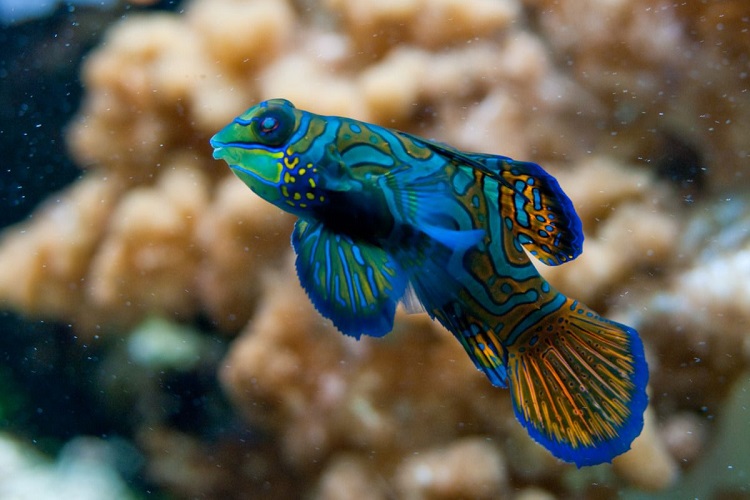
Seeing this popular saltwater fish on the list may surprise you! However, while they’re very popular, they often don’t do well in a mixed reef tank, and we certainly wouldn’t classify them as beginner saltwater fish.
The issue lies in their diet. They are picky eaters and combined with a shy nature, they’re a difficult category of saltwater fish to keep alive. They often starve themselves, even when given a great diet, let alone where the diet lacks.
You will need to either purchase live copepod foods for them (incredibly pricey) or be willing to culture them yourself. While some owners manage to get them to eat shrimp nauplii, they may not take to it.
Hippo Tang (AKA Dory)
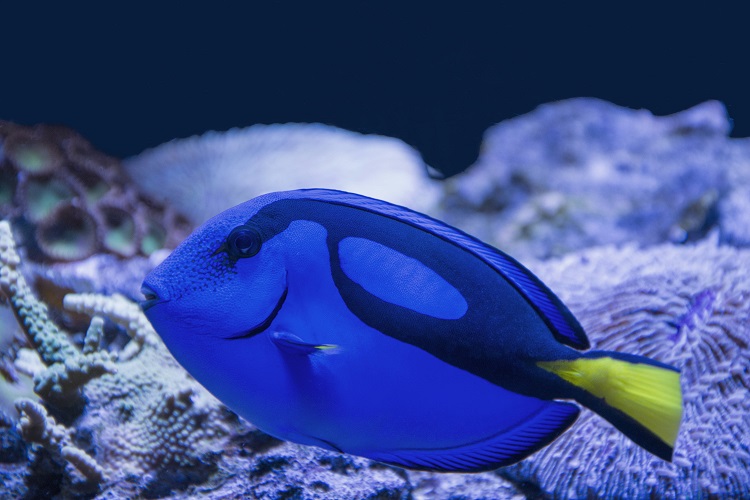
There are a lot of names for this fish, all of which end in “tang.” It has become iconic because of Finding Nemo, but they’re often mistreated in beginner reefs. It’s a sensitive fish, prone to disease and water issues, and very active. It’s also very large when fully grown, even though they’re sold at only a few inches big.
Most beginner attempts to own Hippo Tangs end in death or the fish being rehomed, so skip them until you’re much more experienced.
Wrasses
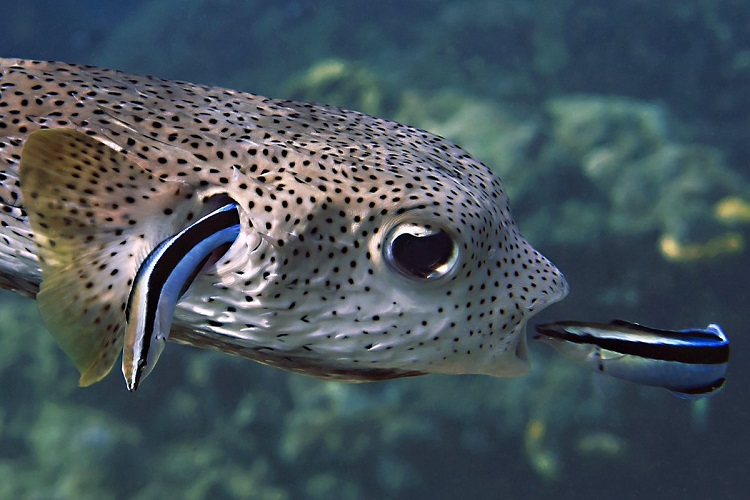
Sadly, many Wrasses have issues in captivity. The Bluestreak Cleaner Wrasse, in particular, often starves in captivity. This is because it relies on parasites, and these aren’t often found in a clean saltwater tank. Six-line Wrasses are difficult and often a little aggressive, but they do keep bristle worms down.
The Melanurus Wrasse and Yellow Coris Wrasse are easier to handle if you really want a Wrasse species.
Damsels
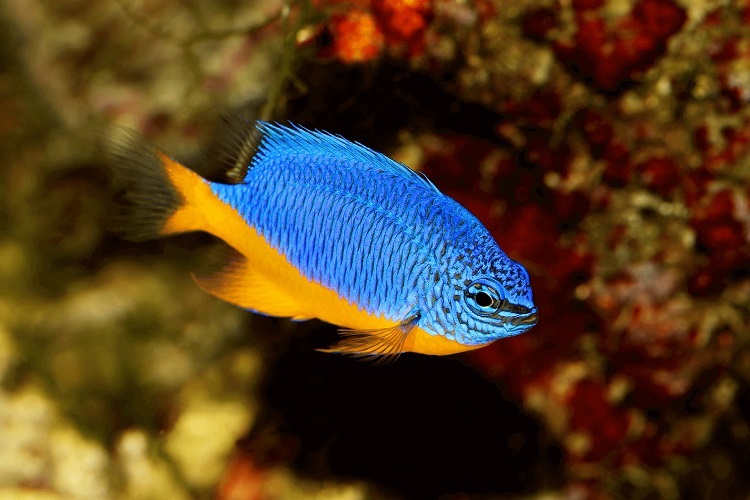
Damsel fish often make the list of coveted saltwater fish. However, they’re very territorial fish. Because they can often fixate on other reef invertebrates, this can quickly become problematic. Tangling with a Sea Hare Slug, for example, can lead to it releasing its ink—and destroying your whole tank!
Despite this, they are perpetually recommended to beginners, and it’s well worth handling that advice with caution. They’re often cheap, good-looking, and stay small, so they seem appealing on paper. They just really don’t do well in community tanks and aren’t beginner-friendly.
CopperBand Butterflies
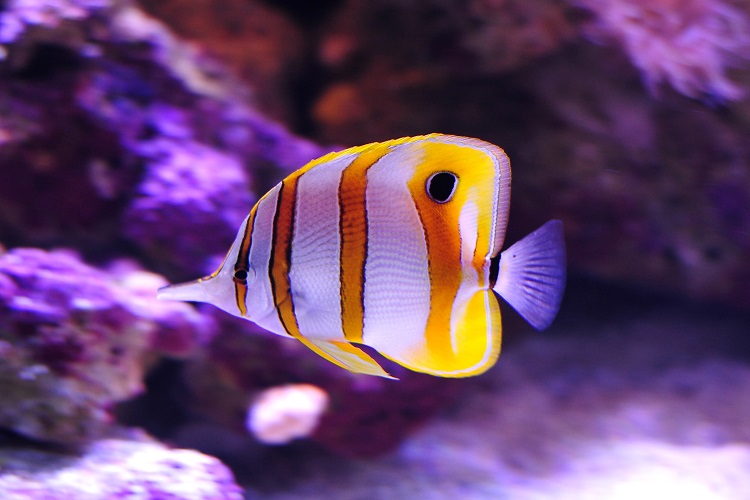
Very beautiful, but as difficult to feed as the Mandarin fishes. They’re also large and active, yet fail to thrive if there are bigger or more active fish in the reef. You also need an excellent reef system for them to thrive at all.
It’s not a beginner-friendly fish at all, so save this beauty for later in your adventures.
Saltwater Tank Setup for Beginners
A saltwater aquarium can seem intimidating, and it is a more complicated aquarium type than basic cold water or tropical aquariums. So, understanding the needs of a basic setup is key. Saltwater fish are also an expensive hobby compared to their freshwater counterparts, so you don’t want to make costly mistakes!
However, don’t let that put you off of a very rewarding hobby. By taking it slowly and carefully, you can enjoy saltwater fish as a beginner. First, you need to realize that cycling a saltwater aquarium can take up to 6 weeks, and often averages 4. Second, most saltwater fish need a lot more space than freshwater fish, so plan accordingly.
Now, remember these key points:
- Compile a solid “stocking list,” with careful thought to space and, if trying for more than one species, compatibility and aggression
- Remember that even peaceful saltwater fish can dislike similar species in the same tank
- Tanks must fully cycle before any fish are introduced
- Choose beginner-friendly saltwater fish
- Add new fish slowly and test the water parameters regularly
- Be vigilant with tank maintenance.
By keeping these steps in mind, your journey into saltwater fish will be a lot easier.
How Hard is it to Keep Saltwater Fish?
Despite their reputation, many of the popular saltwater fish types are hardy and will be forgiving of your first mistakes. It’s not that keeping them is difficult, just that it’s a more complex process than with freshwater fish. With balanced parameters, any algae under control, and a level head, you will thrive with your new saltwater tank.
Salinity is an important water quality parameter that isn’t present in freshwater tanks. It should always be around 1.020–1.025. Saltwater evaporates quickly, and you can’t just top it off like a fresh tank. So, to keep your salinity constant, you either need an auto top-off system or the patience to do the math.
Algae is a problem that often surprises beginners. It comes about because of a mix of factors, including the water you use, your salt mix, and the lights. New tanks take a while to “settle” and stop looking ugly, and you’ll need to go through the learning curve to learn about nutrient flow in your tank.
Because saltwater fish are pricier than freshwater, losing a fish can be devastating. And so-called “tank crashes,” where you lose the whole tank, do happen. Power outages, faulty equipment, aggressive fish, and disease can obviously cause this. Surprisingly, the invertebrates you need for your reef ecosystem can expel ink or toxins that will kill a tank too.
You’ll get used to having a quarantine tank on hand, and some medications to help ailing fish. Don’t get discouraged—these are teething problems everyone faces, and you will learn what you need with time. Taking it slow will help with damage control.
Establishing a beautiful saltwater tank is a fantastic milestone, and it’s a great hobby to get into, so keep your spirits high.
Are Saltwater Fish Tanks High Maintenance?
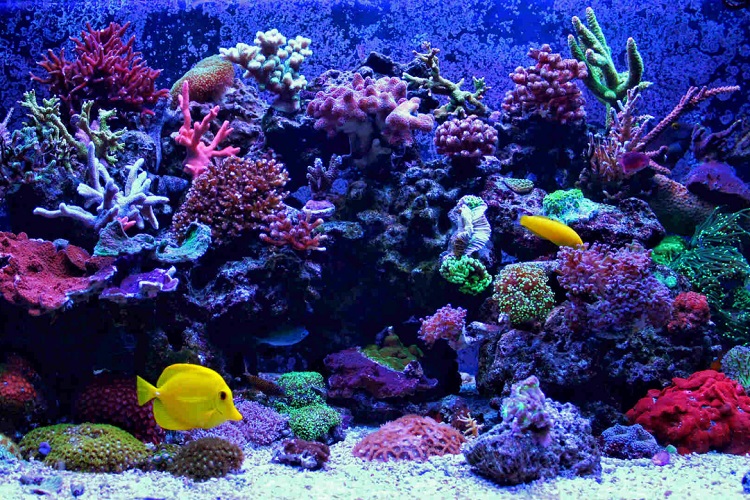
Compared to basic freshwater setups, they can seem high maintenance. A solid routine will help offset that. In a new tank, you have to change the water more regularly, and will definitely need to test, test, test! Your tank is still growing its “good bacteria” and balancing the new invertebrates and fish coming in. This will ease with time and as the tank becomes established.
The more complex your setup—for example, coral-dominant tanks—the harder it will be to establish, so a fish-only setup might be good to start with.
Most experienced hobbyists only need to spend an hour or two on maintenance each week, topping off the water and possibly changing it.
What is the Best Beginner Saltwater Fish Tank Size?
Both 40-gallon and 60-gallon “breeder” tanks make good starter tanks. They’re standardized, which lowers costs and makes them easy to find. They have a good balance of water volume and don’t take up too much space, while still allowing you to create a diverse tank.
Larger and smaller tanks can work for beginners, but large tanks will need a larger budget to match. Small tanks are cheaper, but need more maintenance and testing, and won’t allow for much biodiversity.
FAQs
We’re sure you have some questions about the best and worst types of saltwater fish for beginners. Here are the three major questions we often hear:
What is the Most Peaceful Saltwater Fish?
Community reef tanks can be dazzling but they need a careful balance of fish types and personalities. This makes them harder to manage in saltwater tanks than in freshwater, but you can still make them work.
Most of the recommended beginner saltwater fish on our list do well with at least some other species, but you will still need to double-check your compatibility and stocking before you purchase.
What is the Most Aggressive Saltwater Fish?
While some advanced saltwater fish enthusiasts love the idea of a predatory tank (instead of a traditional reef tank), they can be more complex. However, they’re a great choice if you like statement fish.
While big teeth and spikes are a clue that a species is aggressive, some very innocent-looking fish can be just as aggressive, like the Damselfish. Individual saltwater fish also have their own personalities, so have a backup plan on hand in case aggression issues develop in your tank, and do your research diligently.
What is the Easiest Saltwater Fish to Keep?
Ok, so now you’re a little cautious and just want an easy saltwater fish friend to take care of. Try a tank-raised Clownfish for size. They’re beautiful, come in many varieties, and are very tolerant of beginner learning errors. Tank-raised Gobies can also be good for smaller setups.
Conclusion
While saltwater fish can be intimidating to break into as a hobby, it’s really a case of careful attention to detail and some diligent research. Raising a saltwater tank from scratch can be an immensely rewarding hobby, and one you’ll be proud of for years to come as your fish thrive.
So, don’t be put off by the extra work compared to freshwater! It’s perfectly possible to have a beautiful setup with time and effort, and you’ll love the passion it creates, too.

Ian Sterling, founder of Fishlab.com, began his aquarium journey over 30 years ago, driven by a deep fascination for fish and their diverse personalities. His website, Fishlab.com, is dedicated to making fishkeeping accessible and enjoyable, offering beginner-friendly guidance, expert insights, and a community for aquarists to connect and share experiences.


